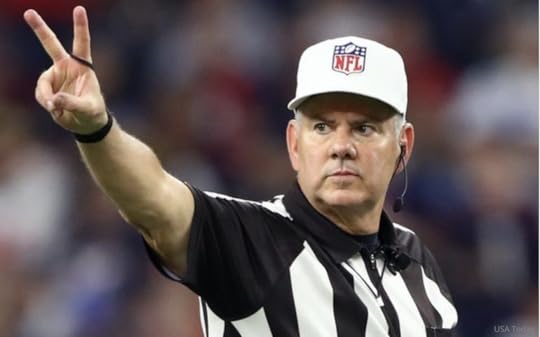Gerry Sandusky's Blog, page 3
May 15, 2019
How to Get a Low Energy Audience More Engaged
It’s a presenter’s nightmare: a low energy audience. You’ve spent real time and effort in preparing your presentation. You brought your A-game to the front of the room. You are ready. And your audience looks they are auditioning for the role of zombies in a new sci-fi movie. Lifeless.
It’s not an impossible situation. In this video, I will share a few tried and true strategies for how to get a low energy audience more engaged. It takes a little extra work on your part and it may require you to veer off your plan a little, but it’s better for everyone—and especially you—to help get your audience into gear so the audience can get into your presentation too.
The post How to Get a Low Energy Audience More Engaged appeared first on Presentation Skills Training | Gerry Sandusky.
April 10, 2019
There’s No “U” In Presentation–And That’s The Problem
Presenters frequently ask me, “How do I make my presentation more engaging.” I usually point out that there’s no “U” in presentation and that’s the problem. By “U” of course I mean “You.” Putting a little bit of personal information in your presentation, a little bit of vulnerability. That increased the chance of an emotional connection with your audience.
Influence starts with emotional connection, not intellectual capital.
In this video, I’ll show you how to use a little bit of “U” to increase your connection with the audience in ways that PowerPoint slides and content alone can’t do.
If you would like to learn more about my presentation and public speaking programs click here: https://gerrysandusky.com/presentation-transformation/
The post There’s No “U” In Presentation–And That’s The Problem appeared first on Presentation Skills Training | Gerry Sandusky.
February 20, 2019
Make Cell Phones an Ally, Not an Enemy in Presentations
Audience members and cell phones literally go hand in hand.
As a presenter, you can tell people all you want to put their phones away. You can ask then to turn them off. But most people are now too attached to their mobile phones to do either. Fortunately, you don’t have to see cell phones as your enemy in a presentation. You can make them your ally and in the process increase audience engagement.
In this video, I’ll show you how to look at the cell phone a little differently as a presenter and how to harness more than just the power of texting, tweeting, posting, and web surfing.
The post Make Cell Phones an Ally, Not an Enemy in Presentations appeared first on Presentation Skills Training | Gerry Sandusky.
February 4, 2019
What Your Organization Can Learn from the NFL’s Bad Call and Worse Approach
Yes, they got the call wrong. Yes, the officials mistake had a direct impact on the LA Rams going to the Super Bowl instead of the New Orleans Saints. And yes, everyone outside the NFL, wants to see replay rules changed.

All of that still misses the bigger issue, an issue that can affect your business as easily as the football business. The issue of transparency.
The referee in the NFC Championship game, was Bill Vinovich. He’s a good ref—or he wouldn’t have drawn that assignment. Did you see his press conference after the game, the one where he discussed at length with members of the media, what went wrong with that call? No you did not because the NFL doesn’t hold press conferences for officials.

Face the Music, or Face the Consequences

Coaches have to face the media. Players too. But not referees.
Most people will forgive a mistake, an honest mistake, one made while trying to do your best. It’s part of the human condition. But they won’t forgive a perceived cover up or hide out.
I don’t think the officials took part in any covert scheme to favor the Rams over the Saints. But the lack of transparency only fuels that kind of dangerous perception.
In New Orleans last week, dozens of people dressed up as blind referees during an anti-Super Bowl parade, protesting the blown call that kept the Saints out of the Super Bowl. But the bigger issue isn’t the call.
No organization, no league, no industry, will ever completely eliminate human error or mistakes. Worth the effort to try. But zero isn’t reality.
The NFL has failed to embrace the idea that if referees had to hold press conferences after games, they would in turn put more pressure on their officiating crews to get the job done right—as well as explain to the public when things aren’t as they appear. No one should be beyond the rules or the conversation about the rules–especially not the people charged with enforcing the rules.
You Owe it to the Market
Any organization owes it to the marketplace to be transparent with information that effects that marketplace.
It’s easy to join the collective outrage, to march in a parade, to thumb your nose at the NFL. But that’s not the most valuable take away. The most valuable take away comes from looking at the mistake the NFL makes with a lack of transparency around its officiating as ask yourself where your organization or your industry makes the same mistake of either cover up or hide out.
The combination of high definition video and social media make everything a public issue in a football game. Police now understand how that works with body cameras. Cell phones make any public setting a potential broadcast. And when information surrounding an error, a major error, hits the marketplace, the marketplace wants answers. Period.
You Make the Call
So the choice is yours. The next time you, your organization, or your industry make a mistake, ask yourself how you are going to handle it. Know that ignoring it or hiding behind policy and protocol are the easiest ways to think you are deflecting criticism in the short term. And know that doing the easy thing in the short term is rarely, if ever, the right thing to do in the long term.
In the digital age, we’re going to have the conversation with the culprit or without him or her. Why not be bigger than the issue and step to the front with transparency? It’s not just a football thing.
The post What Your Organization Can Learn from the NFL’s Bad Call and Worse Approach appeared first on Presentation Skills Training | Gerry Sandusky.
January 14, 2019
Don’t Start Your Presentation with an Agenda Slide
When you watch great movies—from any genre—you’ll notice one consistent thing: They don’t start with an agenda slide. Your presentation shouldn’t either. And largely for the same reason they don’t use them in movies. They’re boring.
The Down Side
Audiences see agenda slide and they start doing a mental calculation of how long everything will take. And if you don’t get to everything, the audience will know that too. That’s a lot of downside.
You want the open of your presentation to have energy, insight, interest. You want to hook the audience, get people engaged, and make time disappear. I’ve never seen an agenda slide to that.
The One Thing Audiences Never Miss
In the above video, I’ll show you a few options for working around agenda slides. And I promise you that when you finish, no one will come up to you and say, “I really wish that presentation had included an agenda slide.”
The post Don’t Start Your Presentation with an Agenda Slide appeared first on Presentation Skills Training | Gerry Sandusky.
November 12, 2018
Know When and How to Avoid Jargon in Presentations
Jargon isn’t B.S. It’s shorthand language. Some of it is culture based. 24/7, ASAP, LOL, etc. Some of it is unique to your position, industry, industry, or organization. And every industry and organization has jargon. Everyone has industry has terminology like that. The dead give away is it usually acronyms. Jargon isn’t a bad thing when you speak to people in your industry or organization. Like any good shortcut, it saves time. But when you speak to a broader audience, jargon gets in the way of communication because your audience doesn’t speak the short cut. They don’t know what a vo is or a lower third. That’s TV jargon. And unless you speak TV, you have no idea what I said.
Say What?
Translation: vo=voice over. That’s when the anchor reads a script over top of video that’s playing on your TV screen. Lower third is the line of information that shows up on the lower third of your screen to identify who the person is speaking. For example: Joe Smith, Mayor of Smithville.
Knowing When to Use and When to Avoid
The key to jargon is always the audience. If you know your audience, you’ll know when to use and when to avoid using jargon. In the above video, I’ll help you connect better with your audience and know when to use and when to avoid jargon. And you’ll know it ASAP. Sorry, couldn’t resist.
To learn more about how I work with professionals just like you, one on one via GoToMeeting to help you engage, amaze, and influence audiences, go to www.gerrysandusky.com/coaching
Jargon isn’t B.S. It’s shorthand language. Some of it is culture based. 24/7, ASAP, LOL, etc. Some of it is unique to your position, industry, industry, or organization. And every industry and organization has jargon.
Everyone has industry has terminology like that. The dead give away is it usually acronyms.
Jargon isn’t a bad thing when you speak to people in your industry or organization. Like any good shortcut, it saves time. But when you speak to a broader audience, jargon gets in the way of communication because your audience doesn’t speak the short cut. They don’t know what a vo is or a lower third. That’s TV jargon. And unless you speak TV, you have no idea what I said.
Say What?
Translation: vo=voice over. That’s when the anchor reads a script over top of video that’s playing on your TV screen. Lower third is the line of information that shows up on the lower third of your screen to identify who the person is speaking. For example: Joe Smith, Mayor of Smithville.
Knowing When to Use and When to Avoid
The key to jargon is always the audience. If you know your audience, you’ll know when to use and when to avoid using jargon. In the above video, I’ll help you connect better with your audience and know when to use and when to avoid jargon. And you’ll know it ASAP. Sorry, couldn’t resist.
To learn more about how I work with professionals just like you, one on one via GoToMeeting to help you engage, amaze, and influence audiences, go to www.gerrysandusky.com/coaching
The post Know When and How to Avoid Jargon in Presentations appeared first on Presentation Skills Training | Gerry Sandusky.
October 10, 2018
How to Use Transitions to Improve Your Presentations
Transitions help transform presentations from a collection of parts into one cohesive whole.
Every presentation has multiple sections: The open, key point one, key point two, etc. And while some sections are more important than others, the presentation has to stand as one whole unit to be totally effective.
The keys to making a presentation with multiple parts feel like one complete unit is to have a theme for the presentation and to use effective transitions between the various parts of the presentation.
This video will show you not only how and where to use transitions in your presentation but also how to make them feel seamless so your audience doesn’t even see them there.
The post How to Use Transitions to Improve Your Presentations appeared first on Presentation Skills Training | Gerry Sandusky.
September 13, 2018
How to Keep from Losing Your Place in a Presentation
Every presenter shares this fear: What if I lose my place in a presentation? What do I do then?
The answer is, drum roll please…don’t lose your place.
I know, easier said then done. Until now.
In the video above, I’ll show you a simple technique that involves using a water bottle and the outline for your presentation.
It will keep you on track every time without the audience even knowing that you’re looking at your notes or outline.
The post How to Keep from Losing Your Place in a Presentation appeared first on Presentation Skills Training | Gerry Sandusky.
August 29, 2018
How Much is Too Much in a Presentation?
There’s a pretty good chance you are busier today than you were five or ten years ago. So is everyone else I meet. So is everyone you face in a presentation.
It’s a common complaint: “I’m so busy. I never have enough time.”
Why everyone is in that situation is a topic for another day, but recognizing that there is a universal condition of feeling overwhelmed is an important step toward building the content in your next presentation.
Avoid Too Much in Your Presentations
Presentations work pretty much along the same lines of most things your mother probably taught you as a kid: Too much of a good thing is no longer a good thing.
When it comes to content in your presentation, keep in mind that your audience is probably already overwhelmed with the 9,573 things on their to-do list. They don’t have much breathing room.
Cramming one more key point, one more slide, one more spreadsheet, one more study into your presentation doesn’t usually serve your audience.
It overwhelms them.
Stick to the Rule of 3
When constructing your presentation outline, have the discipline to limit your key points to no more than three. You don’t have to use three. Just don’t use more than three.
If you go beyond three key points, you will usually overwhelm your audience, leaving them with more information than they can process and you’ll lose control of what information they take away from your presentation.
Let’s Dive In
In this video, I’ll take a closer look at How Much is Too Much in a Presentation?
The post How Much is Too Much in a Presentation? appeared first on Presentation Skills Training | Gerry Sandusky.
August 1, 2018
What an NFL Coach Can Teach You About Presentations
With football season starting up again I find myself spending a lot of time around coaches. My father was a long time NFL assistant coach. I’ve seen first hand that the coaches who last and who win, not only know the X’s and O’s, but they also know how to communicate.
Coaches make presentations every day to their players. Not just the dramatic locker room speeches you see in highlights or in films, but teaching presentations, performance review presentations, planning presentations.
Coaching is another word for teaching. And it might surprise you to see what an NFL coach can teach you about presentations.
In this video, I’ll show a straight-forward, three step approach to looking at presentations and all leadership communication, like an NFL head coach.
The post What an NFL Coach Can Teach You About Presentations appeared first on Presentation Skills Training | Gerry Sandusky.



